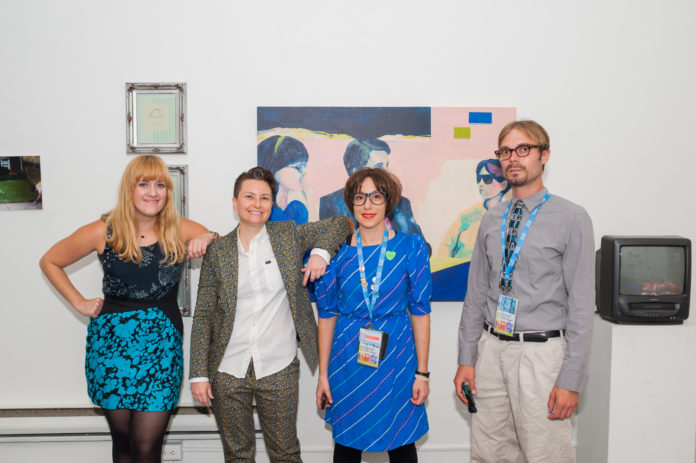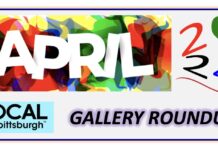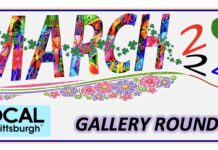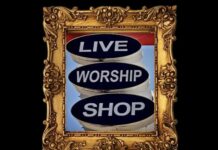Last week, LOCAL visited Clickbait: The App Expo, and now we are getting the chance to chat “IRL” with artists Ashley Andrews and Ashley Andrykovitch, creators of the App Expo.
What sparked the idea for The App Expo?
Ashley Andrews: Bigfoot. Well, a Bigfoot convention. We were chillaxin’ at a dive bar in Irwin, Pennsylvania, that apparently sometimes hosts a Bigfoot convention, and we thought it would be funny to set up a booth and pretend like we were Bigfoot experts. I think it was then we developed our first app – a Bigfoot finder. I guess eventually the app idea took over the Bigfoot idea and here we are, still creating conceptual apps all these years later.
Ashley Andrykovitch: We’ve been working on this project for about five years. And it’s not typically something that appears in a gallery. We’re both artists, I typically work in paint and she typically works in photo and video, and so we decided we wanted to do something that reached outside of the gallery and we wanted to reach people who weren’t typically coming to our gallery shows. So, we came up with this plan and it featured Bill, the systems analyst pro of the app expo. He was a character developed by Ashley Andrews, and he is depicted all over this exhibition. He was the first piece of the puzzle.
Can you tell us more about this character – “inventor” of the internet Bill?
Ashley Andrykovitch: When we did talk about his character and came up with his background, we decided that maybe he was from 1994 and that he is the inventor of the internet, and has been systematically backing it up on discs since it was invented. But the internet is growing exponentially, all the time, even as I’m saying this… so you can imagine how time-consuming it is, so whenever Bill arrives in public to impart wisdom about his invention the internet or apps, his information is a little off.
Ashley Andrews: Bill is not merely some external stereotype or made-up character. Bill is one of the many selves who make up the whole of who I am. I have always been a technology-focused computer nerd, I feel natural assuming the cultural concept of a male, and I look really great in little tiny ties. The character of Bill is so naturally himself that he doesn’t hide the fact that his body is that of a woman’s. He lets his chest exist unbound, you might see a sports bra strap peeking out of his shirt, his female curves are undeniable. But he goes with it anyway and keeps on being Bill. I think a lot of us can identify with some aspects of this reality.
Aside from gender performance, Bill also plays within the curious world of workplace dynamics. This is where my personal connection with Bill splits and he takes on his own character traits. As a male in the male dominated field of technology, Bill fully embodies a version of a late 1980’s, early 1990’s tech boss, and all the assorted chauvinism and ego-driven insensitivity that goes along with that. His interactions with Ashley’s character, Jackie, highlight the submissive, second fiddle role that so many females are culturally instructed to take, especially in a workplace environment.
Ashley Andrykovitch: Whenever you see Bill and Jackie in videos or during public performances, there’s always some aspect of Bill talking over her or she might be trying to make a point, but he’ll talk over her and will say what she was saying – again. It’s a subtle thing, but it happens anytime we do video work or live performances.
Why 1994? What was your life like then?
Ashley Andrews: The infinite potential and the obvious dangers of technology have been themes in my life since my family got our first personal computer, or PC, in the late 80’s. I grew up with this weird, clunky, simple but complex machine that seemed to hold limitless potential if you just knew how to work it right. I guess you could say we grew up together… we both became more advanced, learned new languages, got better at art. I was a different kind of kid – very technical and very attracted to digital image making, while finding comfort in online chatrooms, instant messenger (RIP), and surfing the wild unknown of The World Wide Web. So much of who Bill is overlaps with some of the oldest, truest parts of my own self.
I like 1994 because it was a time when PCs had infiltrated the market. Pretty much every family I knew had one. AOL was getting some traction. People had this whole new way of connecting that they never had before. I was just as competent at the computer as all the adults I knew, since we were all learning this thing called technology together. But one thing that was different for me was that, as I was developing my human skills of communication, I suddenly had this internet thing I could choose to use, and it felt right and really exciting to me. There was this brave-new-world mix of innocence and potential that I think has informed the landscape of The App Expo’s work.
Can you tell me more about your residency in Las Vegas and the App Expo’s appearance there?
Ashley Andrews: Our self-designed residency took us to Interop, a technology conference we attended in character, as well as to a desert so we could perform a technology ritual, and also an intense study session with a female impersonator. It was all about improving our understanding of our characters from many angles and in many different situations. After we left Las Vegas, The App Expo suddenly felt very real, like we knew we were on to something big and important.
The App Expo has been featured in the Warhol and Carnegie – how have you both drawn inspiration from art history and other artists, and how do you think this is truly different?
Ashley Andrews: We both attended art schools and studied art history and studio art, so it’s no mistake that there are obvious influences and nods toward historical pieces of art in The App Expo. Cindy Sherman is a huge influence on my work, especially with her unveiling of a new body of work on Instagram recently. I’m very interested in what technology and the digital can do when in the hands of a classically trained artist. I want to find out who the artist was who created the graphics in the first release of Windows. That person is my art hero.
Ashley Andrykovitch: When we started, we decided that we weren’t going to stress about things being perfect, and that’s another aspect of the App Expo – we wanted to do something imperfect. We didn’t necessarily care as much about the product but were more interested in the process and the ideas behind it. For me, it’s been very freeing. I found that something has happened with my paintings from working on the App Expo, working on something that has not been completely perfect has made it so I can make something like these…There’s also a lot happening with my paintings from being at Fallingwater. It’s more architectural and landscape-based. I think it’s all in my subconscious.
What is your favorite work in the exhibit?
Ashley Andrews: I love to watch people interact with our enormous IRL minesweeper installation. There is no wall label saying what the piece us or how to play it, which cracks me up. Those who know the game recognize it immediately, and those who don’t know it have to stare at it for a while. It’s fascinating to watch a person debate within themselves if they’re allowed to touch the art or not. The piece is always left in a half-played state, so it looks like you should be able to interact with it…. but, what if it’s just supposed to look that way intentionally? I love the conversations I overhear on this topic. So much art is untouchable, and I love that we make people question that assumed standard with this piece.
Ashley Andrykovitch: I just think of it all as one big work, like a ball of yarn, wound together. It’s hard for me to separate it. I think my favorite part about showing at 707 and 709 was seeing people I’ve never seen before looking at our work. And that’s been very fun – new people discovering Bill and Jackie. During the opening, it was unique in that we’ve seen people we’ve never seen before. But that goes for Pittsburgh, in general – it doesn’t happen very often, so that was cool. It’s been great. Thanks, Pittsburgh Cultural Trust!
Can you tell me more about the framed piece you created with the old floppy disks and leaves inside?
Ashley Andrews: I found those discs in Allegheny Cemetery in Lawrenceville. They were half buried in the ground along with other trash. I couldn’t believe it. The discs made me ask so many questions…. who buried these? What’s on them? Is it something illegal? Or just someone’s backup files? Also, I mean, jeez, I excavated old floppy discs from a cemetery. That alone could be the premise of a movie.
Technology is so coveted when brand new, and so quickly disposable when out of date. Can our environment keep up with everything needed to sustain this cycle? Raw materials need extracted, factories need to make these things, transportation needs to move them around, people need to buy them, landfills need to permanently house them within a few years. Can we come up with a better system?
What about the work with the table and the plates? Can audiences interact with this, as well?
Ashley Andrykovitch: This is a piece from an installation we did with UnSmoke Systems in Braddock. We decided to use that space and made it into a chat room and we put these chatroom prompts here on the table and it broadcast it into the other room in the gallery. In case someone had forgotten to speak face-to-face, we wanted to give them the prompts because we are so disconnected and always on our device. When you sit down face-to-face, you might be awkward and we wanted to go easy on people. They sat down with each other, combinations of strangers. They did [use the plates] and would just hold them up like the one asking “A/S/L” and you’d see the person across from them answer “F-female…” It’s a sign of the times, too. It was completely binary, but it was the 90s. 
During the Gallery Crawl [for the 707/709 exhibit], they were allowed to sit [at the table] and at Bill and Jackie’s desk. Our stuff is highly participatory. That’s another reason we don’t worry about the precision of the objects that we’re making, because we would prefer that people handle them, sit on them or crawl into them…There’s usually a physical aspect and we don’t care if things get broken.
What is the Digital Reliance Support Group?
Ashley Andrykovitch: The DRSG used to meet monthly, but it’s a one hour meeting where Bill and Jackie collect everyone’s phone for an hour…and then Bill and Jackie do tons of therapeutic activities. Always something crazy enough that people itch for their phones to record or photograph what’s happening. They always do something Instagram or Snap-worthy, so it’s uncomfortable for people not to be able to. One successful one we had was at Arsenal Lanes and it was karaoke night. The DJ let us sing every other song as Bill and Jackie…Bill and Jackie sang an insane amount of songs and took over if anyone else tried to sing. We had other meetings where Bill led creative visualization meditation. Humor is a really important part of the App Expo. Hopefully, that makes it inviting.
What is next for the App Expo?
Ashley Andrews: Fall 2018, we’re having our next App Expo group show at Assemble in Garfield that will mimic a convention center with booths set up, promos given away, swag bags, app walk-throughs, product demos, you know the scene. A classic App Expo.
This show has a lot of humor and insight, but what do you really want audiences to take away from this show?
Ashley Andrykovitch: I would hope that maybe they might be considering their own level of technology use day-to-day. What does it do for you? Maybe they’ll come to the conclusion that their life was made so much better since Twitter was invented. Maybe they will have “Whoa, Buddy!” downloaded to their Internal Organic Operating System and realize “Hey, I need to go out into the real world and just talk to people face to face every now and then.” You know – for their health and well-being.
Ashley Andrews: Technology and the digital world are relatively new concepts for humanity to think about, play with, make art with, and make art about. It’s just what we do when presented with something curious in our environment. What we’re doing with the App Expo is not so different from ancient cave drawings in Lascaux, France. We’re creating art based on what we know, what we grew up with, and what we’re immersed with today. I hope this show prompts audiences to step outside their routine and consider the effect technology has on their lives, both positive and negative.
If you can’t get enough of Clickbait or are just curious to meet the legendary inventors Bill and Jackie, attend the Artist Talk at 707 and 709 Gallery on November 3rd at 7pm.
Photos courtesy of Emily O’Donnell and the Pittsburgh Cultural Trust.













